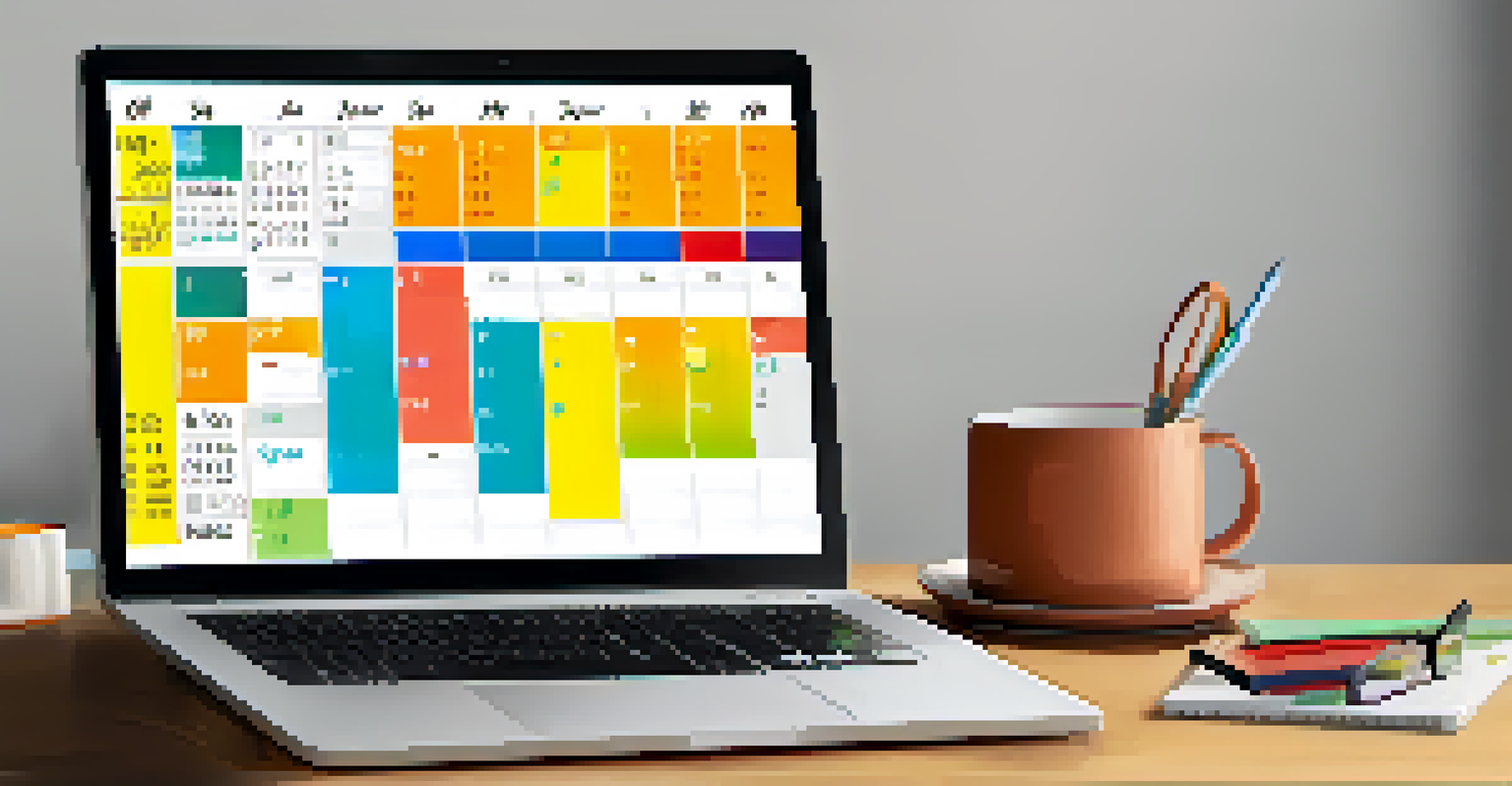Time Blocking Techniques to Optimize Your Work-Life Balance

Understanding Time Blocking for Better Focus
Time blocking is a productivity technique where you schedule specific blocks of time for different tasks. This approach helps you focus better by reducing distractions and creating a structured routine. Imagine treating your schedule like a puzzle, where each piece represents a task that fits perfectly within your day.
Time management is life management.
By dedicating chunks of time to specific activities, you can avoid the trap of multitasking, which often leads to decreased productivity. Think of it as compartmentalizing your day, allowing your brain to fully engage in one activity at a time. This focused approach not only enhances efficiency but also helps reduce stress.
As you become more accustomed to time blocking, you might find it easier to stay on track and maintain momentum throughout your workday. Ultimately, this technique allows you to allocate time for both work and personal life, leading to a healthier work-life balance.
Setting Up Your Time Blocking Schedule
Creating a time blocking schedule begins with identifying your priorities and current commitments. Start by listing out all your tasks and categorizing them into personal, professional, and self-care activities. This will give you a clear overview of how you want to allocate your time.

Next, consider your peak productivity hours—those times when you feel most energized and focused. By scheduling your most challenging tasks during these periods, you can tackle them with greater efficiency. For instance, if you’re a morning person, block off your early hours for deep work and reserve afternoons for lighter tasks.
Time Blocking Boosts Focus
This productivity technique reduces distractions and enhances efficiency by dedicating specific time slots to tasks.
Finally, remember to include breaks in your time blocking schedule. These short periods of rest are essential for maintaining your energy levels and preventing burnout. A well-structured time block might look like a 90-minute work session followed by a 15-minute break, ensuring you stay refreshed and productive.
Using Technology to Enhance Time Blocking
In today’s digital age, leveraging technology can significantly enhance your time blocking efforts. Various apps and tools, like Google Calendar or Trello, allow you to visualize your schedule and set reminders for your tasks. This not only helps keep you accountable but also adds a layer of flexibility to your planning.
The key is not to prioritize what's on your schedule, but to schedule your priorities.
For example, with Google Calendar, you can color-code your blocks to differentiate between work, personal, and family time. This visual representation makes it easier to see how your day is structured at a glance. Additionally, many of these tools offer features like recurring tasks, which can save you time in planning.
Experiment with different apps to find one that suits your style and needs best. The right technology can help transform your time blocking from a mere concept into a practical application, greatly enhancing your productivity and work-life balance.
Adapting Time Blocking to Your Unique Needs
One of the great things about time blocking is its flexibility; it can be tailored to fit your unique lifestyle and preferences. For instance, if your work involves frequent meetings, you might need to adjust your blocks to accommodate these interruptions. It’s all about finding a rhythm that works for you.
Consider experimenting with different block lengths and styles. Some people thrive on 25-minute blocks followed by short breaks, while others may prefer longer, uninterrupted sessions. The key is to listen to your body and mind, adjusting your approach as necessary to maintain your productivity.
Technology Enhances Time Blocking
Utilizing apps like Google Calendar can help visualize and manage your time blocks effectively, increasing accountability.
Moreover, don’t hesitate to re-evaluate your time blocking strategy periodically. Life is dynamic, and what works today might need tweaking tomorrow. Regularly assessing your schedule ensures that you’re always optimizing your work-life balance.
Combating Interruptions with Time Blocking
Interruptions can derail even the best-laid plans, but time blocking can help mitigate their impact. By clearly defining your work periods, you can communicate your availability to colleagues and family, setting boundaries around your focused time. This proactive approach helps manage expectations and reduces unwelcome distractions.
When interruptions do occur, having a designated time block for quick responses can be helpful. For example, you might allocate 15 minutes at the end of each hour to check emails or address quick questions. This way, you’re not completely cutting off communication but are also protecting your focused work time.
Remember, it’s also okay to be flexible if an interruption is urgent. The goal of time blocking is to increase productivity, not to create rigid barriers. Just make sure to adjust your schedule afterward to accommodate for any time lost.
The Benefits of Time Blocking for Personal Projects
Time blocking isn’t just for work-related tasks; it can also significantly benefit your personal projects. Whether you’re working on a hobby, a side hustle, or even household chores, allocating specific time blocks can transform how you approach these activities. It turns the overwhelming into manageable chunks, making it easier to progress.
For instance, if you’re passionate about painting but struggle to find time, block out an hour on weekends specifically for this activity. By treating it as a priority, you’re more likely to commit to it regularly. This not only nurtures your creativity but also contributes to your overall happiness.
Flexibility is Key to Success
Adapting your time blocking strategy to fit your unique lifestyle ensures that it remains effective and aligned with your needs.
Additionally, dedicating time to personal projects helps create a sense of accomplishment and fulfillment. As you check off completed tasks, you’ll likely find that you’re more motivated to continue, reinforcing a positive cycle of productivity in both your personal and professional life.
Evaluating Your Time Blocking Effectiveness
As with any strategy, it’s essential to evaluate how effective your time blocking is in achieving your desired work-life balance. Take a moment at the end of each week to reflect on what worked, what didn’t, and how you felt throughout the week. This practice can provide valuable insights into your productivity patterns.
Consider keeping a journal or using a simple checklist to track your achievements and any areas for improvement. For instance, did you frequently find yourself over-scheduling, or did you enjoy ample downtime? Recognizing these patterns can guide your adjustments moving forward.

Ultimately, the goal of time blocking is to create a sustainable routine that enhances your work-life balance. By continually assessing and refining your approach, you can ensure that your time blocking technique remains effective and aligned with your evolving needs.